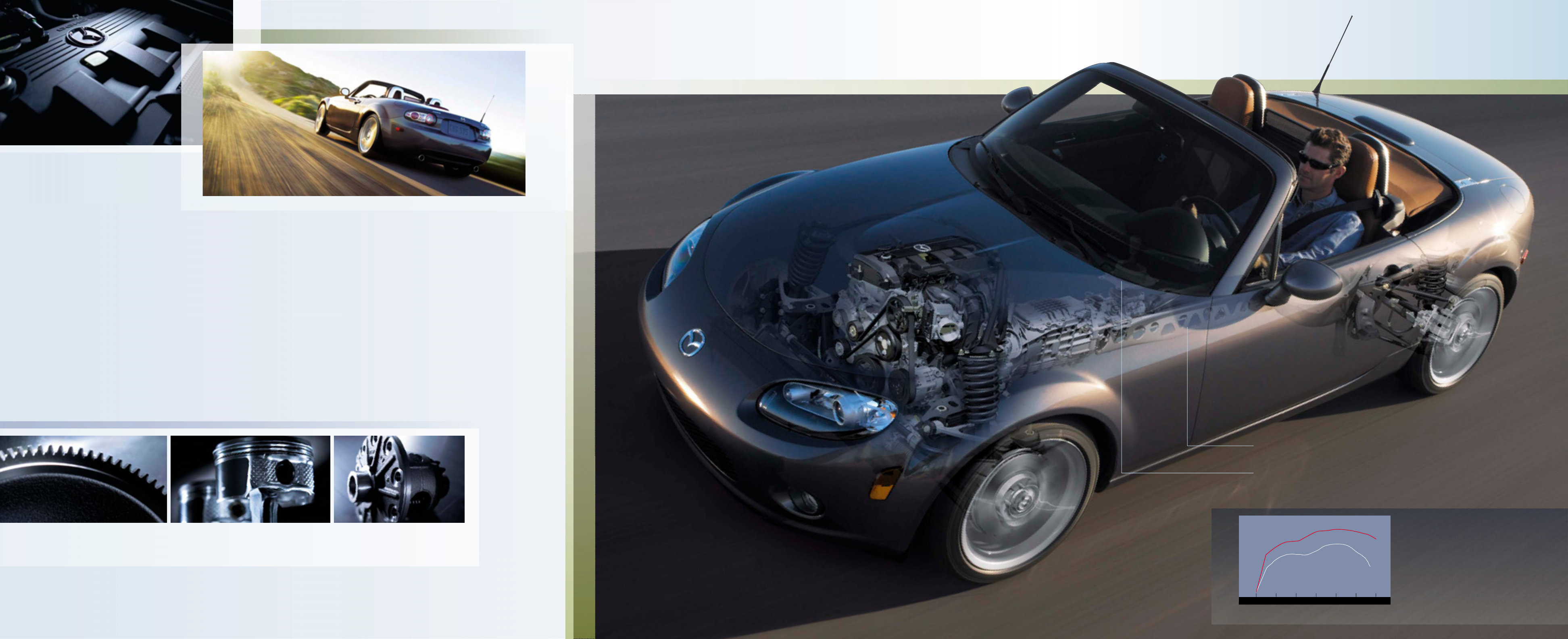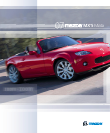
70
90
110
130
150
1000 2000 3000 4000 5000 6000 7000
ENGINE SPEED (rpm)
ENGINE TORQUE (lb-ft)
Previous 1.8-Liter Engine
New 2.0-Liter Engine
An aluminum Power Plant Frame (PPF) unites engine, transmission and differential into a rigid unit. This structural “backbone”
helps ensure that maximum power reaches the rear wheels and helps eliminate drivetrain twist and acceleration delays.
True to its sports-car heritage, a short-throw, close-ratio 5-speed manual gearbox is standard on the MX-5 Miata. Also available are
a slick-shifting 6-speed manual and a 6-speed Sport AT automatic transmission. The Sport AT’s competition-inspired design allows
you to manually shift gears via the shifter or steering-wheel-mounted paddles.
Now in its third generation, this MX-5 Miata boasts a larger,
more powerful 166-hp 2.0-liter DOHC 16-valve engine.
Endowed with a higher and broader torque curve, especially
in the mid-rpm range, it generates an abundance of more
useable power. Variable valve timing and variable induction
are also utilized to maximize low-end torque and high-rpm
power. Its advanced design even incorporates an electronic
throttle and electronically controlled port fuel injection to
promote a more linear response and superb acceleration.
It’s all about
generating more power per pound.
A. B. C.
A. The MX-5 Miata utilizes an ultralight flywheel to enhance the engine’s free-revving performance and improve its responsiveness. B. Friction-reducing, molybdenum-coated pistons
plus a high-compression ratio help the current MX-5 Miata engine generate 17% more horsepower than the previous generation’s powerplant. C. A limited-slip differential and Dynamic
Stability Control with Traction Control System are available on select MX-5 Miata models.
* Based on a comparison of model year 2006 roadsters.
Weight is the enemy of every true sports car. So Mazda engineers implemented a radical, weight-saving “gram strategy” to make certain that every critical
component in this 3rd-generation MX-5 Miata was as light and strong as possible. Which is why everything from its powerful 166-hp engine and handsome
hood to its sleek trunk lid and rear brake calipers are all crafted from aluminum. And why its ultrarigid body structure makes such generous use of high-tension
steel. Light and strong, it helps increase torsional stiffness 47% and flex stiffness 22% compared to the previous generation MX-5 Miata. It also helps improve
virtually every aspect of the car’s dynamic performance—including power delivery, steering, handling and braking. Which is why it’s more agile and more
responsive. And in dramatic contrast to some roadsters hastily assembled from shared off-the-shelf parts, the MX-5 Miata is a true purpose-built design.
Which readily explains why it’s nearly 400 pounds lighter than some competitors.
*
And, most important of all, why the Mazda MX-5 Miata is able to forge
such a unique, intuitive feeling of oneness between car and driver.

















